What if I told you:
There is a special type of fish food that can keep your fish fed for up to two weeks?
You probably wouldn’t believe me, right?
Well, that product actually exists: slow release fish food.
[sc name=”slow-release-fish-food-block-text-links-code”]
Today, I am going to teach you everything you need to know about this magical fish food, including why it isn’t suitable for most aquariums.
API 5/5
| ||
TetraPond 5/5
| ||
Zoo Med 5/5
| ||
TetraVacation 5/5
| ||
Zoo Med 5/5
| ||
Zoo Med 5/5
| ||
Zoo Med 5/5
|
Contents
What is slow release fish food?
Slow release fish food covers any type of fish food that can be used as a food source over days or weeks, without needing you to be nearby.
At first glance, slow release fish food doesn’t look like anything special.
Just a hard, oversized block of fish food.
When you place this block into your aquarium, it begins to dissolve.
As the block breaks down, it releases food, much to the joy of your hungry fish.
But how does that help you?
Well, let’s say you want to leave your home for a few days. Maybe you have to travel for work or want to take a much needed vacation – how do you feed your fish while you are away?
Slow release fish food does the feeding for you. Put a block or two in your tank, and your fish will be fed until you return.
Types of slow release fish food
Not only does slow release fish food come in different shapes and sizes, but also ingredients and flavors.
These flavors vary enough to keep all types of fish satisfied, from bettas and bottom feeders to marine fish and even pond fish.
But while slow release fish food varies dramatically from one brand to the next, there is one thing that remains constant…
Slow release fish food is categorized by how long it keeps your fish fed.
1. Weekend feeder blocks last up to 3 days – just long enough to keep your fish fed for a short trip away from home.
1. Vacation feeder blocks last up to 14 days – long enough for you to enjoy a long road trip or relaxing vacation.
Simply choose the right feeder block that matches how long you will be away from home, and you are good to go. Well, almost…
Do you need to use slow release feeder blocks?
I’m going to be straight with you, slow release fish feeders are the worst way to feed your fish while you are away from home.
First, in order for feeder blocks to dissolve correctly, you need to ensure that your tank has both adequate filtration and water movement.
Without these two features in your tank, you risk the feeder block not dissolving properly or worse, only partially dissolving and turning your water into a cloudy mess.
Next, slow release fish feeders are best suited for smaller fish, and not too many. There isn’t exactly a lot of food in a slow release feeder block. A fully stocked tank or fish that need a bigger meal will be left hungry.
But even if you have good circulation and the right fish, adding a feeder block to your tank can be a huge mistake! Not only will some fish refuse to eat it, but it can destroy your water quality too.
If you are seriously considering using slow release feeder blocks, check out auto fish feeders first. This handy little device can feed your fish their favorite food without you needing to be nearby.
With that said, slow release fish food is still a popular solution to feeding your fish while on vacation – particularly for beginners with easy-to-care-for fish.
And if you are still reading this, then you probably want to use slow release food for your fish tank.
So, now you need to find out whether the brand you have is right for your tank…
Because there are so many different types of slow release fish foods available and aquarium setups, it is nearly impossible to know how a vacation feeder block will react in your tank.
Fortunately, it’s pretty easy to find out…
Do a trial run while you are home!
When you fed your fish the first time, did you add food to the tank and walk away? Or, did you watch to ensure that your fish buddies were actually eating?
Of course you watched!
Well, you should do the same thing with slow release fish food.
Add a slow release block to your aquarium and monitor how it reacts over time.
What you want to do here is monitor the following:
1. Are your fish actually eating the feeder block?
Slow release fish food will be very different to your fish’s current diet. While some fish take to feeder blocks immediately, others will refuse to eat it.
If your fish refuse to eat the slow release fish food, you might as well leave them with nothing when you are away from home.
2. Does it mess with the water quality of your tank?
The last thing you want to return home to is a full-blown algae outbreak and your fish floating belly up.
Continually test the water quality as the slow release fish food dissolves into your tank – if you notice any scary fluctuations, remove the feeder block from your tank immediately.
I would like to add…
Three-day slow release food is a waste of your time. Most fish can happily survive this long without eating.
The best slow release fish food
Before I continue, I want to stress the importance of choosing the right slow release feeding block for your fish. You can’t add a pleco block to your tank and expect your betta to eat it.
Below are some of the most popular slow release fish foods on the market:
1. Best all-around slow release fish food
Ingredients (Click to expand)
Corn Gluten Meal, Wheat Middlings, Wheat Flour, Pea Protein, Brewers Dried Yeast, Lecithin, Dried Kelp, Dicalcium Phosphate, Canola Oil, Spirulina Algae, DL-Methionine, Garlic, L-Lysine, Vitamin A Acetate, L-Ascrorbyl-2-polyphosphate (source of Vitamin C), Vitamin D3 Supplement, Vitamin E Supplement, Thiamine Mononitrate, Riboflavin Supplement, Niacin, Folic Acid, D-Biotin, Copper Sulfate, Zinc Sulfate, Inositol, Mineral Oil, preserved with Methylparaben, Propylparaben, BHT, and BHA.
| Crude Protein (min) | 1.5% |
| Crude Fat (min) | 0.06% |
| Crude Fiber (max) | 3.0% |
| Moisture (max) | 18.0% |
| Calcium (min) | 19.0% |
| Calcium (max) | 21.0% |
This is one of the longest-lasting slow release fish foods on the market. One block will feed 5-10 average-sized fish (2 inches) for up to 14 days.
API claims that the feeder block meets the nutritional requirements of all aquarium fish – goldfish, freshwater, tropical and saltwater.
Now, let’s take a closer look at some species-specific feeder blocks…
2. Best slow release fish food for betta
Ingredients (Click to expand)
Calcium Sulfate, Fish Meal, Wheel Starch, Wheat Gluten, Magnesium Sulfate, Brewers Dried Yeast, Shrimp Meal, Spirulina, L-ascorbyl-2-polyphosphate (source of Vitamin C), Vitamin A Acetate, Choline Chloride, a-Tocopheryl Acetate (source of Vitamin E), Niacin, Calcium Pantothenate, Riboflavin, Thiamine Mononitrate, Biotin, Pyridoxine Hydrochloride, Folic Acid, Menadione Sodium Bisulfite Complex (source of Vitamin K), Cholecalciferol (source of Vitamin D3), Vitamin B12 Supplement, Zinc Proteinate, Copper Proteinate, Manganese Proteinate, Iron Proteinate, Ethoxyquin (a preservative).
| Crude Protein (min) | 4.0% |
| Crude Fat (min) | 0.01% |
| Crude Fiber (max) | 2.3% |
| Moisture (max) | 21.0% |
Capable of feeding a single betta for up to 7 days, this feeding block contains shrimp meal, fish meal and other vitamins and minerals to keep your little betta full and healthy.
How many do you need? One feeder block per betta.
3. Best slow release fish food for pleco and catfish
Ingredients (Click to expand)
Calcium Sulfate, Plankton, Powdered Cellulose, Spirulina Algae, Magnesium Sulfate, Dicalcium Phosphate, Niacin, L-Ascorbyl-2-Polyphosphate (stabilized Vitamin C), Thiamine Hydrochloride, d-Calcium Pantothenate, Pyridoxine Hydrochloride, Biotin, Beta Carotene.
| Crude Protein (min) | 1.0% |
| Crude Fat (min) | 0.25% |
| Crude Fiber (max) | 4.0% |
| Moisture (max) | 18.0% |
| Calcium (min) | 23.0% |
| Calcium (max) | 28.0% |
A tasty meal of plankton, wood fiber and algae – a favorite of any pleco. One block lasts up to 7 days.
How many do you need – Add one banquet block for 2-3 small catfish or 1 medium/large catfish. If you notice your fish being aggressive during feeding time, add another.
4. Best slow release fish food for critters (shrimp, crabs and small crayfish)
Ingredients (Click to expand)
Calcium Sulfate, Plankton, Spirulina Algae Meal, Magnesium Sulfate, Dicalcium Phosphate, Niacin, L-Ascorbyl-2 Polyphosphate (stabilized Vitamin C), Thiamine Hydrochloride, d-Calcium Pantothenate, Pyridoxine Hydrochloride, Biotin, Beta Carotene.
| Crude Protein (min) | 2.5% |
| Crude Fat (min) | 0.25% |
| Crude Fiber (max) | 1.5% |
| Moisture (max) | 18.0% |
Your shrimp will go crazy over this meal of plankton and spirulina. One block lasts up to 7 days.
Conclusion
Again, I don’t like slow release fish food. It doesn’t offer any advantages over using an automatic fish feeder – seriously, consider one of these first before choosing to use slow release fish food.
I respect that many people find success with these feeder blocks, and that’s why I spent the time to dedicate an article to them.
Do you use slow release fish food when you are away from home? I would love to hear your thoughts.

Ian Sterling, founder of Fishlab.com, began his aquarium journey over 30 years ago, driven by a deep fascination for fish and their diverse personalities. His website, Fishlab.com, is dedicated to making fishkeeping accessible and enjoyable, offering beginner-friendly guidance, expert insights, and a community for aquarists to connect and share experiences.


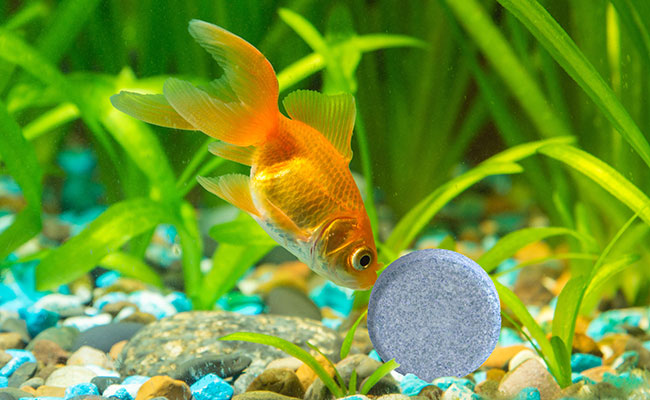







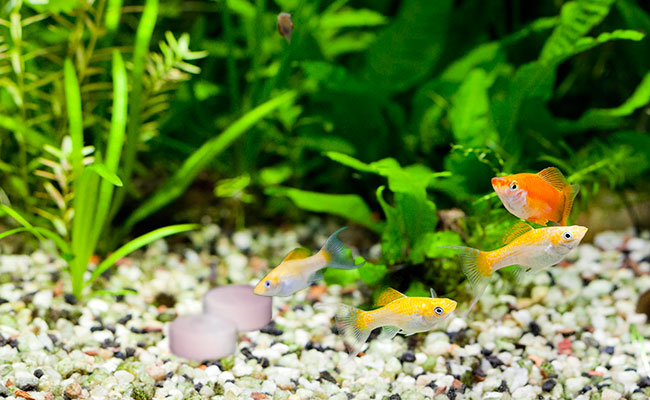
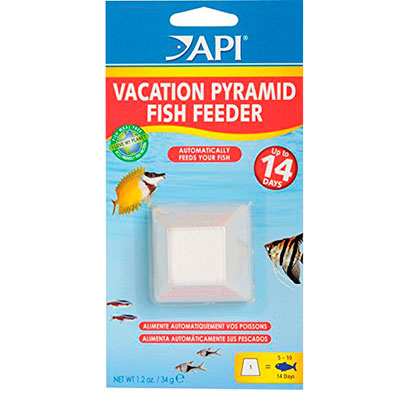

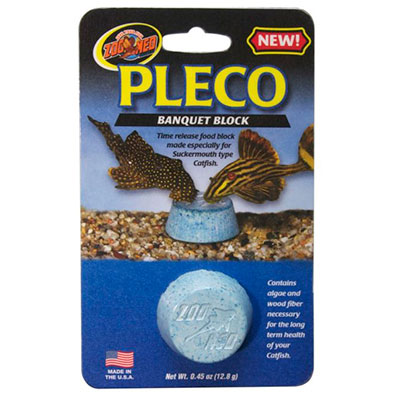
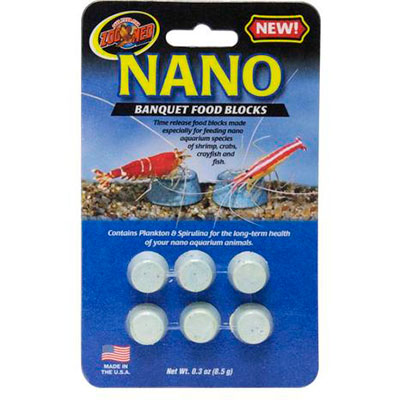
Comments (15)
These don’t work they just make your tank cloudy. What a waste of money. hungry fish and ruined water.
Hi Lora,
Sorry to hear about your terrible experience. It is for this reason that I recommend that you use an automatic fish feeder instead. This device allows your fish to enjoy their regular meal, even without you being there to feed them!
Not good!!!!!!!! fogged up my tank and killed my fish.
Hi Erica,
I’m terribly sorry about your experience. Unfortunately, this is a risk with slow feeder blocks. That’s why it’s always a good idea to test the blocks before you leave home. That way you can save your tank if anything goes wrong.
I went away for 15 days and used a 14 day block and it worked great for 3 large gold fish in a 20 gallon tank with filtration.
I am curious, could 2 three day blocks work for a week’s vacation?
Hi Rita,
Good question. Probably not as I imagine the the 3 days recommendation takes into account the rate at which the block dissolves.
I went away for 10 days. Before I left, I did a partial water change, and dropped the gel covered 14 day vacation tablet in. I had read the gel is better for keeping your tank cleaner. Crumbled off a little bit a dropped it in the tank so my fish would go see what it was. She did and realized it was food, so I dropped the remaining whole tablet in and she immediately began nibbling at it. I checked it the next morning before I left for my trip as I had done this experiment the night before, and you could tell she was enjoying it. I can back 10 days later, and the water wasn’t cloudy, and you could visably see where she had been feeding on it. So overall I had a great experience and wos recommend the gel tablets 10 out of 10
Hi Jennifer,
Thanks for sharing your experience, I am relieved you came back to a trouble-free tank, that’s awesome!
I used “Pro Balance Betta Vacation Feeder” from Petco while we were gone for 4 days. When we returned he was very fat, so I figured he had stuffed his face while we were gone. I did a water change because I knew these feeders can mess with water quality. I also made him fast for 24 hours. Well he developed Dropsy. But it came on slowly. I treated him for it but he got so sick that I had to humanely euthanize him. My beautiful 6 month old baby Betta “Cloud” is now in fish heaven.
I’m convinced that there was some sort of parasite in the vacation feeder that killed him.
I will never use a vacation feeder on my fish again. I’m buying a automatic feeder next time.
Hi Krista,
Thanks for sharing your experience. I’m sorry for your loss.
Hello,
I have a Blackmoor in a 21 (us gallon) tank, I use a Fluval 3 for filtration, a dual out put air pump with a heater set at 21 degrees Celsius. We had 2 Fish bought in 2012 but unfortunately one died a few weeks ago. I am going on holiday in just over a month for 14 nights and will have my Sister who will keep popping by to make sure everything is ok. (my sister is an experienced fish keeper). we feed the fish on Tetra Goldfish flake, I am better using either 1) a 14 day feeder block, 2) Shorter term blocks (ie I’ve been on weekend vacations and used Tetra Goldfish weekend sticks which have worked) or buy a auto feeder? (my fish does not like pellets though and I’m concerned that flakes tend to jam up auto feeders) any advice you can give me will be greatly appreciated. Also when I do get back from my holiday I am planning on getting a new friend for this fish. would you recommend me getting a fish of a similar size or would he be ok with a baby fish?
Hi Richard,
It sounds like your best bet is to get your sister to feed your fish. Most fish will happily go 7 days without food, so spacing out his feedings shouldn’t hurt. Also, I would suggest reading up on tank sizes for blackmoors and goldfish in general, they need a fair bit of room. On size, large enough to not be eaten is fine.
Hello fellow fish lovers! I have a 10 gallon tank with 1 fairly large goldfish, 5 zebra’s and 2 snails. I also have a 2 gallon with 1 betta. My husband had a medical emergency and when I found out he was going to be in the hospital for 2 + weeks, I went to Petco to buy an automatic feeder but they were sold out so the sales person suggested Pro Balance vacation blocks. I made sure to buy betta specific for our betta. I was REALLY nervous about what we would come home to but 11 days later, both tanks were clean and all the fish seemed quite happy! That said, thank you for writing this. I’m going to go get an auto feeder to have on hand. It sounds like your playing a bit of Russian roulette with these tabs!
Hi Bridget,
I’m really happy to hear your experience was a positive one. I imagine your medical emergency was stressful enough without something going wrong with feeding your fish. I agree with your thoughts on Russian roulette – but in your situation it sounds like you did the only thing you could. I hope your husband is doing okay!
Hi im very new to this fish keeping hobby and im loving it i have a 20 gallon tank 3 fish all different sized goldfish from 1″ then 2″ and my big boy 3-4″ 1st i get quite a bit of bacterial bloom and i tried everything to keep it at bay……2nd do the fish eat the holiday block of does it just dissolve into the water and the fish breathe it in ?
Many thanks
Stephen O’Rourke